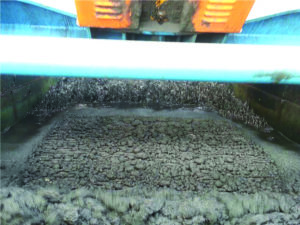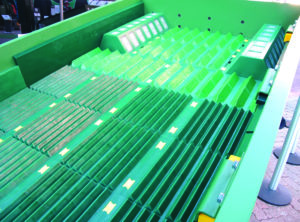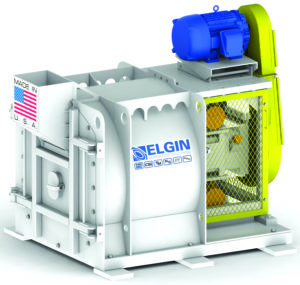A ridged screen panel and a compact horizontal vibratory centrifuge offer miners the chance to replace bigger machines
by jesse morton, technical writer
Two suppliers told Coal Age that feedback from the field has proven the viability of two dewatering solutions that were designed to deliver optimal performance in a comparatively small footprint. Corrugated screen panels that met with success and fanfare in Australia offer double the open area of flat panels, theoretically allowing smaller machines to significantly increase capacity. And a relatively new horizontal vibratory centrifuge proved it can replace a bigger machine and reduce maintenance and operating costs.
Both solutions were developed in response to requests from customers. Afterward, they were trialed in applications differing from those for which they were originally developed. Now they are gaining wider market acceptance. Testimony from the suppliers shows why that is quite likely to occur.

The above high-frequency dewatering screen uses TeePee Panels in the center. The sides have standard slotted apertures. The filter cake is drier in the center than on the sides. (Photo: TEMA ISENMANN)
Ridged Panels Offer More Capacity
TEMA ISENMANN reported it will release a new TeePee Panel model along with accompanying fasteners in 2021.
The corrugated panel has double the open area and drainage of comparable conventional screen panels, and it offers more efficient dewatering and increased capacity, the company said.
“Typically, if you had to stretch out the 1-by-1-ft TeePee Panel, it would have a flat surface area of a 1-by-2-ft panel, and hence it has doubled the open area,” said Anthony Yell, division manager, mining, TEMA ISENMANN.
Cross-flow apertures are embedded in the ridges over the full length of each panel and have a self-relieving taper to reduce potential pegging and blinding. “All apertures are slots ranging in width from 0.315 mm to 1.4 mm and with a length of 10 mm,” Yell said.
“In addition, the peaks of the TeePee’s ridges rake the underside of the feed, reducing surface tension, releasing entrapped water,” he said, “which in turn improves the dewatering capability of the panels over conventional flat panels.”
That and the structural integrity of the corrugated design have been proven at Australian sites, with significant deck loadings in dewatering applications in iron ore, coal, lead and zinc, the company reported. “The ridges effectively crack the compacted bed with each stroke, while water liberated from the interstitial spaces is squeezed against the screening surface, promoting more effective dewatering capabilities on each panel.”
Because the panel was designed to dewater iron ore, it “has a heavy-duty internal structure to carry high loads plus the surface is designed for extended life,” Yell said.
Because the panels offer higher capacity over less space, they allow for a smaller dewatering screen to be used, which reduces capex costs, he said. Or the panels can increase the dewatering capacity of an existing machine.
Another benefit offered is the more efficient recovery of water for reuse. “Processing raw coal requires a lot of water,” Yell said. “To be able to efficiently recover water and reuse it benefits the environment and reduces costs.”
Historically, TeePee Panels have been successfully installed in a range of dewatering applications “from aggregate to diamond, gold, iron ore, platinum and coal applications around the world,” Yell said. “North American coal mines can benefit from this technology as it will reduce their operating costs.”
The TeePee Panel was “originally developed by our sister company, Multotec Manufacturing, in South Africa,” Yell said. “It came out of a think tank where we looked at a range of 3D panel configurations to improve open area without compromising panel life.”
The initial aperture was a 0.5-by-9.8 mm slot across flow with 20.74% open area, a white paper by the company stated. “Comparing this to a standard flat panel, with a 0.5-by-13 mm slot with 10.1% open area, it has more than double the open area,” it said. “Comparing the TeePee open area to a panel with a 0.5-by-8.8 mm slot and 14.94% open area, the increase in open area of 38.82% is significant.”
The original TeePee Panels were open-cast polyurethane installed on a heavy minerals plant to dewater the feed, Yell said. “The predecessor screens were too small to handle the required capacity, and there was no space to install large dewatering screens.”
The panels “resolved the dewatering capacity problems, and are still used successfully to this day,” he said. “These panels handle bed depths in excess of 1 ft and still dewater effectively.”
Demand for high-open-area panels from Australian iron ore and coal miners prompted the supplier to develop a more “cost-effective solution that could be mass produced for market requirements,” Yell said. “We developed the injection-molded panel that not only is more cost effective to manufacture, but the design was refined, improving open area and drainage rates as well.”
In the field, the design quickly proved viable.
“Test work carried out on dewatering of iron ore spiral classifier product showed an improvement from more than 20% down to 15.62% in the moisture content of the filter cake,” Yell said. “As a result, the plant converted all their dewatering modules to TeePee Panels. Results showed an average reduction in the filter cake moisture content of 6.2%.”
Testing on a belt filter in 2012 showed that raking or striating “a fine coal filter cake during dewatering increased the air flow through the cake, reducing the moisture content of the cake by up to 7%,” the white paper reported. TeePee Panels “perforate and disturb the filter cake underneath, resulting in increased air flow, release of water, and a dryer product.”

Open-cast and injection-molded TeePee Panels on a screen deck. The ridges crack the compacted bed, while liberated water is squeezed against the screening surface. (Photo: TEMA ISENMANN)
The panels “put grooves in the underside of the filter cake, opening it up and releasing entrapped water,” Yell said.
The panels are modular and can be retrofitted to any screen that uses 1-by-1-ft panels. “It is just a matter of simply changing out panels from flat to TeePee Panels,” he said.
TeePee Panels deliver best results when part of a “holistic approach” to dewatering, the company reported. Other contributing factors to success include ensuring the optimal vibrating screen size, gravitational force, stroke, bed depth and cut sizes, TEMA ISENMANN said.
The gravitational force should be a minimum of 4.5 to 5 Gs. “Furthermore, it needs to compact the filter cake sufficiently to squeeze out excess moisture,” the white paper reported.
TEMA ISENMANN “will shortly be launching the WS85 modular TeePee Panel, which can be installed on any of our WS85 rail systems, available in North America,” Yell said.
Low-tonnage Centrifuge Cuts Costs
Elgin reported the CMI HVC-1000-101 horizontal vibratory centrifuge offers leading-edge dewatering technology in a smaller footprint with lower operating and maintenance costs.
The unit is ideal for low-tonnage applications, Elgin said. “We have frequently seen much bigger machines in applications that do not require that size machine,” Kevin Whisler, engineering manager, Elgin, said. “The HVC-1000 is often a better fit.”
Field results show it offers cost savings on maintenance and consumables. “One of our first installations replaced a screen scroll machine in a small coal application,” he said. “While the product moisture was slightly higher than before, which was expected and acceptable, the reduction in consumable parts usage and operating cost was much better than expected by the mine site.”

The CMI HVC-1000-101 horizontal vibratory centrifuge has a 20- or 35-hp rotation motor and can generate g-forces ranging from 50 to 550. It is designed to cut maintenance and operating costs in lower-tonnage applications. (Image: Elgin)
A different customer “replaced a competitor’s larger vibratory machine with much the same results: consumable parts reduction and lower maintenance costs,” Whisler said.
The unit is designed for lighter feed rates. It features a compact size “capable of processing coarse or fine particles at 80 to 100 tons per hour,” the company reported. It “can operate at speeds ranging from 300 to 1,000 rpm, allowing operators to easily make adjustments based on material flow for consistent g-force.”
The HVC-1000 has a 20- or 35-hp rotation motor, two 1.5-hp vibratory motors, an oil bath lubrication system, and can generate g-forces ranging from 50 to 550. It is 90 in. long by 70 in. wide by 77 in. high and weighs 6,000 lb.
“It incorporates our leaf spring system and two-degrees-of-freedom vibration system to produce extremely low levels of vibration,” Whisler said. The springs neither rust nor corrode, nor require maintenance. The vibration system uses “twin adjustable vibration motors to dial in on frequencies to facilitate feed size and load.”
Both 30° and 15° wet end rotation configurations are available to accommodate feed types.
The lubrication system requires no pump, filter, gauges or pressurized oil lines, Elgin reported.
“Left and right hand swing configurations are available for the front door hinge,” it said. “Maintenance is accomplished above the floor, maximizing availability of your operation.”
That maintenance will be comparably minimal, Elgin reported. “The HVC continues the tradition of industry-leading durability.”
The lubrication system requires very little maintenance and features a convenient oil sight glass and easily accessible fill and drain ports, it said. “To further ease maintenance, the CMI HVC-1000 screen takes minutes to change with simple hand tools.”
The vibration system results in extremely low vibration transmission to the supporting structure, Whisler said. “No isolation elements are required under the machine, and the structure need not be designed to accept such forces.”
The vibration system runs equally well on both 60- and 50-Hz power without a variable frequency drive, Whisler said.
Motors and vibrators can easily be converted in the field, Elgin reported. The centrifuge uses a toothed and reinforced belt drive for reduced belt burn-off and reduced noise.
The features, lightweight design and benefits offered “make the HVC-1000 the common-sense solution to all your particle dewatering applications,” it said. The centrifuge is available in either a 1000, 1400 or 1500 configuration and “is easily installed in nearly every coarse particle circuit.”
The newest in the series of horizontal vibratory centrifuges, the unit was released in 2018 following the release of two bigger machines. “We found markets for a smaller machine that incorporates all of the technological developments that have been established in the larger machines,” Whisler said. “We are finding applications for this machine in both coal and non-coal industries.”
This demonstrates the company’s drive to invest in and develop new solutions that speak to specific customer needs. “In recent years, no other company has developed new dewatering technology for coal that achieves comparably lower maintenance and operating costs,” Whisler said.




